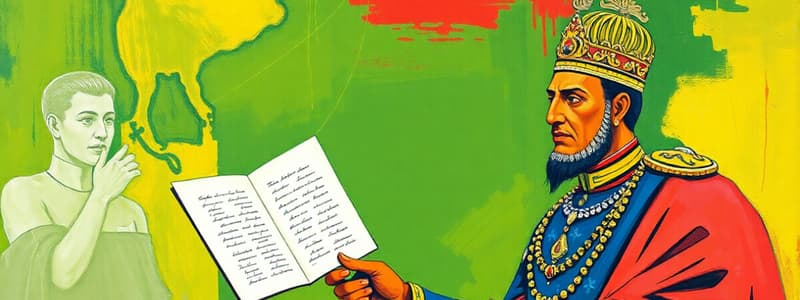Podcast
Questions and Answers
Which European power was initially granted trading privileges in Siam in the 16th century?
Which European power was initially granted trading privileges in Siam in the 16th century?
- France
- Portugal (correct)
- Britain
- The Netherlands
What action did King Narai's generals take when he fell ill?
What action did King Narai's generals take when he fell ill?
- They formed an alliance with the British.
- They closed the borders to all foreigners.
- They requested assistance from the Dutch.
- They drove out the British and French. (correct)
Which country was allowed to continue trade in Siam after King Narai's generals took control?
Which country was allowed to continue trade in Siam after King Narai's generals took control?
- Britain
- Portugal
- France
- The Netherlands (correct)
What was the primary aim of the Bowring Treaty signed between Siam and Britain in 1855?
What was the primary aim of the Bowring Treaty signed between Siam and Britain in 1855?
What did the extraterritoriality clause in the Bowring Treaty entail for British subjects in Siam?
What did the extraterritoriality clause in the Bowring Treaty entail for British subjects in Siam?
In return for the trading privileges granted to Britain through the Bowring Treaty, what did Britain guarantee to Siam?
In return for the trading privileges granted to Britain through the Bowring Treaty, what did Britain guarantee to Siam?
Which reform did King Mongkut implement to demonstrate Siam's equality to Western powers?
Which reform did King Mongkut implement to demonstrate Siam's equality to Western powers?
What was the purpose of King Mongkut encouraging Western education among his children and government officials?
What was the purpose of King Mongkut encouraging Western education among his children and government officials?
Who tutored the children and wives of King Mongkut, later inspiring a famous musical?
Who tutored the children and wives of King Mongkut, later inspiring a famous musical?
What was the main focus of King Chulalongkorn's reforms, in contrast to his father's emphasis on cultural changes?
What was the main focus of King Chulalongkorn's reforms, in contrast to his father's emphasis on cultural changes?
What key administrative change did King Chulalongkorn implement to weaken the aristocracy's control?
What key administrative change did King Chulalongkorn implement to weaken the aristocracy's control?
In what year did King Chulalongkorn abolish forced labor and slavery in Siam?
In what year did King Chulalongkorn abolish forced labor and slavery in Siam?
What action did King Chulalongkorn take to modernize Thailand, similar to his father’s approach?
What action did King Chulalongkorn take to modernize Thailand, similar to his father’s approach?
How did the reforms of King Mongkut and King Chulalongkorn collectively contribute to Siam’s independence during the age of imperialism?
How did the reforms of King Mongkut and King Chulalongkorn collectively contribute to Siam’s independence during the age of imperialism?
What was the main reason why France and Britain guaranteed the independence of Siam?
What was the main reason why France and Britain guaranteed the independence of Siam?
What name was Thailand known by when Europeans first arrived in Asia in the 16th century?
What name was Thailand known by when Europeans first arrived in Asia in the 16th century?
Which treaty marked the beginning of Siam's opening to Western trade and influence in the 19th century?
Which treaty marked the beginning of Siam's opening to Western trade and influence in the 19th century?
What specific benefit did France gain from its agreement with Siam following the Bowring Treaty?
What specific benefit did France gain from its agreement with Siam following the Bowring Treaty?
Which of these actions by King Mongkut demonstrated his effort to modernize Siam and be seen as equal to Western powers?
Which of these actions by King Mongkut demonstrated his effort to modernize Siam and be seen as equal to Western powers?
How did the reigns of King Mongkut and King Chulalongkorn contribute to Thailand being the only Southeast Asian country to avoid colonization?
How did the reigns of King Mongkut and King Chulalongkorn contribute to Thailand being the only Southeast Asian country to avoid colonization?
Flashcards
What was Siam?
What was Siam?
Historical name for Thailand when Europeans arrived in the 16th century.
What is the Bowring Treaty?
What is the Bowring Treaty?
A treaty signed in 1855 that opened Siam to trade, lowered taxes, and allowed British land ownership and extraterritoriality.
What is extraterritoriality?
What is extraterritoriality?
The principle that British citizens in Siam were not subject to Siamese law, but to British law.
Who was King Mongkut?
Who was King Mongkut?
Signup and view all the flashcards
What reforms did King Mongkut implement?
What reforms did King Mongkut implement?
Signup and view all the flashcards
Why did King Mongkut promote Western education?
Why did King Mongkut promote Western education?
Signup and view all the flashcards
Who was King Chulalongkorn?
Who was King Chulalongkorn?
Signup and view all the flashcards
How did Thailand remain independent?
How did Thailand remain independent?
Signup and view all the flashcards
Study Notes
Thailand in the First Stage of Imperialism
- Thailand was known as Siam when Europeans arrived in Asia in the 16th century
- In 1511, the Thais allowed the Portuguese to trade with their kingdom through a treaty
- The royal class and Buddhist monks in Siam disliked the king’s closeness with foreigners
- When King Narai fell ill, his generals seized power and drove the British and French out of Siam
- Only the Dutch were allowed to stay and trade
Thailand in the Second Stage of Imperialism
- King Mongkut believed that being closed off to Westerners would only make them try harder to conquer Siam
- Through diplomacy and negotiations, foreigners were welcomed into the kingdom
- In 1855, Siam and Britain signed the Bowring Treaty, opening Siam to trade
- The Bowring Treaty lowered Siam’s tax on merchandise and allowed the British to own land and set up a consulate in Bangkok
- The treaty gave Britain extraterritoriality in Siam, meaning the British could not be tried in Siam without Britain’s consent
- Britain guaranteed Siam's independence and agreed not to interfere with its government
- Siam entered into a similar agreement with France, allowing them to trade, run religious missions, and send warships to Bangkok
- King Mongkut believed Siam would not be conquered if it demonstrated equal prosperity and cultural sophistication with foreigners
- He introduced coinage as a new monetary system and built more ports and warehouses
- More roads and telegraph lines were constructed to improve transportation and communication
- King Mongkut encouraged his children, government officials, and the royal class to pursue a Western education to better socialize and deal with foreigners
- Anna Leonowens, an English teacher, tutored King Mongkut’s children and wives which later inspired the novel, film, and musical "Anna and the King."
- After King Mongkut’s death in 1886, his son King Chulalongkorn (Rama V) continued to implement reforms
- King Chulalongkorn focused on political and social reforms, unlike his father who focused on cultural reforms
- King Chulalongkorn formed his own council of advisers and established a system of centralized tax collection
- These reforms weakened the aristocracy's control over these systems
- In 1905, King Chulalongkorn abolished forced labor and slavery in Siam which was inspired by Western countries
- Like his father, he valued Western education and sent Thai children from royal families to Europe and America to study and help modernize Thailand
Summary
- Thailand, or Siam, was the only kingdom in Southeast Asia that remained independent during colonialism and imperialism
- This was achieved through the diplomacy and reforms of King Mongkut and King Chulalongkorn
- To prevent conquest by Westerners, they opened Siam to trade and other foreign interests
- By using the teachings and influence of Westerners, Thailand was able to modernize its culture, politics, economy, and society
- France and Britain guaranteed Siam’s independence because it served as a buffer state or neutral zone, ensuring their interests did not clash
Studying That Suits You
Use AI to generate personalized quizzes and flashcards to suit your learning preferences.




